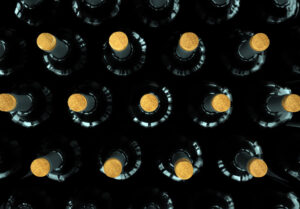The concept of buying wine before it is made available for purchase may at first seem counterintuitive but has been done in Europe for hundreds of years, mostly with the wines of Bordeaux. Thomas Jefferson is widely credited with introducing the practice to the US in the early 1800’s but it remained uncommon until much more recently and is still not very well understood. There are actually two variations on the theme, which may contribute to the confusion. This article will introduce both and discuss in detail the potential rewards and benefits of the less speculative, zero-risk form.
Buying wine as “Futures” (aka en Primeur) is done while the wine is still in production. It has still to age and be bottled before being delivered, typically a period of several years. The “futures” price is generally much lower than the “release” price. Producers accept this because they are willing to exchange higher long-term profits for an immediate influx of cash. Buyers see an investment opportunity; the potential to sell the wines upon release for much more than they paid and pocket the difference. But with this opportunity comes risk. Worst case scenario is that something goes completely sideways during the production and finishing of the wines and the buyer gets nothing. While very rare, this is still possible. A more common, and likely, downside is that, when brought to market, the wine does not command a high enough price to provide a sufficient return on the initial investment. A robust network of advisors and critics exists to hedge these bets, but the market will do what markets do: fluctuate unpredictably. This risk as well as the considerable knowledge, understanding and research required to participate make the Futures market the realm of only the most fervent collectors and investors.
The “Pre-arrival” market, in contrast, is open to everyone. In this model, wines are finished, bottled and ready for release but have not yet been shipped from the winery or brokerage house. Hence the name.
Most commonly the wines are new releases from a winery, either the next available vintage or previous vintages that they’ve held in reserve. Alternately, the wines come from brokers who purchase and store wines from multiple producers and vintages. In both scenarios, the seller offering these “pre-arrival” purchases has secured the availability of the wines thereby eliminating nearly all risk to the buyers. They place orders and take delivery several weeks to a few months later (dependent on the location of the wine, shipping methods and customs).
Buyers reap multiple benefits in exchange for their foresight and patience, chief among them is guaranteed, sometimes exclusive, access to the wines. Many highly sought after wines are made in small quantities. Ordering them on pre-arrival is a way for the buyer to avoid the “feeding frenzy” that accompanies their release to the broad market. Often, when demand is high enough and supply equally low, the wines will not make it to the broad market at all, having been purchased entirely pre-arrival. Whether the buyer’s goal is drinking pleasure or investment, the advantages of securing a wine through pre-arrival are obvious.
While access is the primary driver of the Pre-arrival market, lower pricing is also a motivating factor. For investors, the price gap is not as significant as it is with Futures (and therefore does not provide as large an immediate return) but it does offer mid-to-long term potential. This is especially true for rare and/or in-demand wines. In these cases, prices increase over time due to scarcity and demand driven by press, market trends, FOMO, etc. A lower acquisition cost leads to a higher margin of return.
For Enthusiasts, i.e. those that actually drink the wine, spending less for the object of their desire is welcome but there is also another huge benefit: the increased width and depth of selection via the Pre-arrival Market. As endless as the variety in shops and restaurants may seem, it is a mere drop in the worldwide ocean of wine. This is because importers and distributors cannot plausibly offer EVERYTHING. Thus, the curators of retail shelves and restaurant lists are selecting from a finite pool of choices; large yes, enormous even, but ultimately finite. The Pre-arrival Market invites the question “What else is out there?”, spurring the curiosity of Enthusiasts and igniting the obsessions of Geeks. The answer, of course, is “Everything”. There are many, many regions, producers, specific wines, and/or vintages that for one reason or another are not regularly available via traditional means, if at all.
This is where Education comes in and it works in both directions. A buyer can start by browsing the pre-arrival selections of their favorite retailer(s) to see what catches their eye and then do some research to decide if it’s something they’re in to. Or, the research can come first. Maybe it’s a different bottling from a familiar producer, or a back vintage. Perhaps it’s a region or grape variety that’s never been tried. The buyer begins with the target and then finds the retailer that can hit it with a pre-arrival.
But why would a retailer do such a thing? What’s in the pre-arrival model for them? Fair to say that it’s a tie between building Loyalty and increasing Margin. If a retailer can consistently provide sought-after wines and/or hidden gems to a customer, that customer will likely be faithful with their less exotic purchases. That’s a big advantage in an extremely crowded and competitive market. From a business perspective, pre-arrival sales come with very little added overhead. This reduces the labor and marketing expenses associated with generating sales in the traditional manner. Furthermore, pre-arrival orders are typically picked up or delivered to buyers within days of their arrival, meaning that very little additional storage or display space is needed. In other words, broadening their selection without adding inventory, pretty much the Holy Grail of retail.
That brings us to the producers themselves and the allure of pre-arrival for them. The primary benefit, in the case of low-production, sought-after wines is one of demand management. As an example, consider a wine of which only 100 cases are made. The producer exports this wine to three countries. Optimal outcome is that the amount they allocate to each matches the demand there-in. Sales history, etc is a fairly reliable predictor but markets can vary for unforeseen reasons. What they most want to avoid is the wine sitting un-sold in one place while another is clamoring for it. Offering what’s available on a pre-arrival basis eliminates all guess work. Supply is matched directly with demand. Corollary to this are benefits on the flipside of a few mentioned above regarding Buyers and Retailers. Producers can continue to make these rare, small-lot wines confident in the knowledge that they have a path to consumers. They can then exploit this path to strengthen their relationships, and increase their presence, with distributors and retailers.
The case (get it?) for the Pre-arrival Market has been made. At base, buyers can realize short-term financial benefits and longer-term investment potential due to lower purchase prices. In addition, engagement in the Pre-arrival Market encourages education which results in an overall more well-informed buyer (and drinker). Finally, the If-For-No-Other Reason, it is FUN. Seeking and choosing a wine that is not currently available, financially committing to that selection, waiting patiently for your purchase to make its journey and then celebrating its arrival by popping the cork (or settling it into its new home in your cellar) is an exciting and deeply satisfying experience. One that is available to all, regardless of knowledge, budget or taste.
Ready to get started?
Here are a few recommendations from your trusted guides at SaratogaWine.com:
2020 Tua Rita Giusto di Notri – Super Tuscan – 240 bottles available
2020 Les Carmes Haut Brion – Bordeaux – « A Masterpiece » : 100pts Vinous
2014 Bollinger La Grande Annee – Champagne – « Stunning » : 98pts Vinous
2017 Les Forts de Latour & 2015 Chateau Latour – just released by the winery in June






